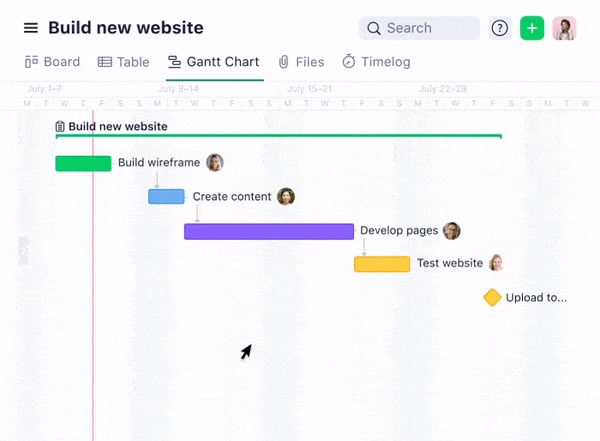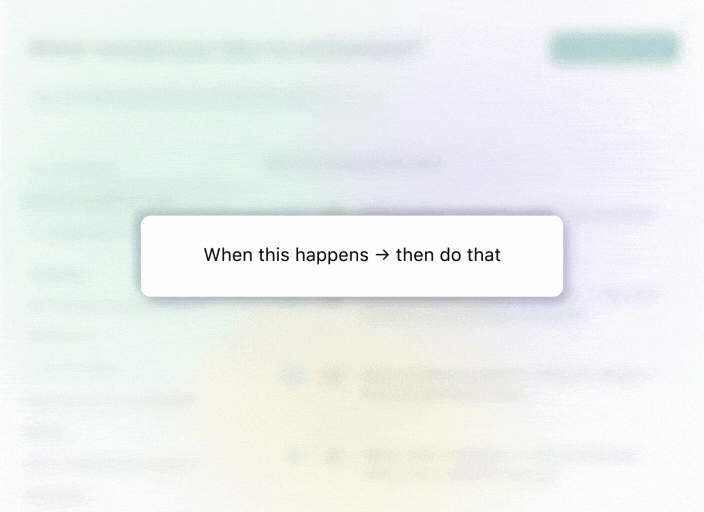Need a cloud-based project management tool for your business? Wrike and Trello both provide user-friendly solutions for managing tasks and projects within a team. While Wrike specializes in custom workflows and tailored communication to include all stakeholders, Trello focuses on the task management process with Kanban boards.
There’s some overlap between Wrike vs. Trello, but the tools operate in very different ways.
One way to look at the debate between Wrike and Trello is through the lens of complexity. On the surface, Trello offers a highly simplistic method for collaborating on projects, whereas Wrike provides a more comprehensive set of tools to get the job done.
Another way to view the two tools is in the day-to-day operations. Wrike offers more of a bird’s-eye view approach to project tracking, planning, and execution. Meanwhile, Trello meets challenges head on with a practical method for streamlining a shared workload.
The reality is that both tools have plenty to offer. The option you choose should ultimately come down to your preferences and what your business needs to scale and succeed.
In this guide, we’ll dig deeper than surface level and uncover the feaures behind each project management tool. Our detailed comparison weighs up both solutions’ pros and cons — that way, you can definitely settle the Wrike vs. Trello debate in your office.
What is Trello?
Trello, at first glance, is an interactive Kanban board that fuels team productivity through straightforward drag-and-drop cards and action item lists. Yet the tool offers much more than just a minimalist method for collaboration.
Beneath the surface, you’ll find that Trello empowers team members with a range of integrations, customizable workspaces, and various templates.
As a Wrike alternative that works best for small businesses, Trello can help streamline organization-wide project management. While it may not work as well for the burgeoning business or enterprise, Trello excels in the hands of individual departments or smaller teams.
It’s best used as a simple pipeline-tracking project management dashboard. If you run a content production agency, for example, you can use Trello to visualize each blog post or article as it moves through your pipeline. The first list could represent the brief drawn up for the article, the next could indicate when the writing work is in progress, and then you could account for the editing or publication processes with respective lists.
With a system like this, you can streamline your workflow so that each team member knows exactly what they need to work on at all times.
Here are the main features of Trello’s project management software:
- Cloud-based tools
- Kanban board organization
- Drag-and-drop cards and lists
- Mentions, labels, and comments
- Custom due dates
- Checklists and attachments
- Power-ups (third-party integrations)
- Workflow automation
- Data dashboard
- Multiple views
- Templates
What are the advantages of using Trello?
Teams that use Trello appreciate the simplicity of the software and how easy it is to get set up. Within minutes, you can put together a plan for an upcoming project, break it down into various tasks, and assign those individual tasks to different team members.
By forgoing many features that other project management platforms might offer, Trello can focus on excelling in one area: Kanban-style task management. It’s hard to find another tool that distills the process better and makes it easy for teams large and small to get started on projects quickly.
Beyond basic task management, Trello allows teams to collaborate effectively. Through mentions, comments, checklists, and attachments, project managers can keep an open line of communication with their team from start to finish. Custom due dates help team members stay on track with their workload and ensure everyone is accountable.
Checklists and attachments can add another layer of oversight for project managers. If a task requires several steps or reference documentation, they can see to it that the respective cards reflect the relevant information. There’s no need to send team members over a list of responsibilities or share information through a file-sharing platform.
While there’s a simple visual timeline of progress, Trello also shows you how your team is getting along with the cards. Cards stack up in different lists, which you can create to represent different phases of completion. That way, you know exactly what’s left to do and who’s responsible for which tasks.
Finally, workflow automation saves you time as you can create shortcuts for recurring or trivial tasks that eat into team productivity.
What are the most popular features of Trello?
Trello might seem like a bare-bones project management solution, but the few things it does, it does well. Here are the most popular features of the team productivity platform:
Custom workspace boards
It isn’t uncommon to have various projects ongoing at once, and it’s likely that some tasks and responsibilities overlap. That’s why Trello offers custom workspace boards, so team leaders can quickly navigate from one project to another while seeing how everything fits together with the calendar and table overviews.
If you have multiple projects running at the same time and various task dependencies, Trello’s workspace boards can help you recognize when the dominoes start to fall. You can also bring all the information together, so you have an all-in-one view that encompasses everything.
Drag-and-drop cards
Drag-and-drop cards are the lifeblood of Trello. They’re easy to move and as useful for the project manager as they are for team members. Workspace boards are for the big-picture elements of project management, while cards represent the day-to-day tasks and responsibilities. Users can easily create custom cards and do the following:
- Assign team members
- Set due dates
- Attach files
- Provide checklists
- Add comments
Power-ups
What Trello may lack in functionality outside of task management, it makes up for with what it calls “power-ups.” Projects require more than just productivity, which is why Trello partners with a range of third-party tools to offer many types of integrations, including the following:
- Analytics and reporting
- Automation
- File management
- HR and operations
- Marketing and social media
- Sales and support
With these integrations, Trello can become an all-in-one solution for your project management needs. Syncing information across apps provides a streamlined way to run your projects from start to finish.
This is useful, especially if you already rely on many apps to run your day-to-day operations. For example, if you use a tool like QuickBooks for your accounting needs, you can feed project information, such as time spent on various tasks, directly into your software. That way, you’re guaranteed accurate billing or payroll.
What are the disadvantages of using Trello?
Trello’s simplicity is absolutely a strength and makes it an excellent choice for freelancers, contractors, and small teams. The flip side of this is that for larger teams and enterprise-level organizations, it can be challenging to manage dozens of projects and hundreds of employees with this project management tool.
Another drawback commonly cited by users is that, at times, when overseeing various workspace boards, pertinent information can get lost in a deluge of notifications. When individual updates come from many different sources, project progress can be hindered as team leaders struggle to stay on top of every board, list, and team member.
What is Wrike?
Wrike is a comprehensive project management platform that gives you access to many tools, templates, and analytics you can use to get on top of your project planning. It goes beyond the surface-level features that other platforms offer to get into as much detail as you can handle.
Our enterprise-grade software solution isn’t just a means to manage projects; it’s the methodology to carry out day-to-day operations, the analytics platform to measure progress, and the structure for building templates and processes from the ground up.
Wrike simplifies scheduling by letting you measure capacity and forecast resources while also providing the project management tools to help your team with the execution.
Here are the main features of Wrike:
- Custom item types
- Interactive Gantt charts
- Kanban boards
- Templates
- Custom request forms
- Visual proofing
- Automated approvals
- Time tracking
- Advanced analytics
- AI-powered tools
- Dashboards
- 400+ integrations
What are the advantages of using Wrike?
Wrike provides team leaders with a project management dashboard from which they can manage their teams and projects effectively.
While we offer similar Kanban task management to Trello, Wrike goes one step further and offers interactive Gantt charts that users can view and easily edit to reflect real-time updates. With the Gantt charts, you have a visual way of eliminating bottlenecks and assessing project progress.
Gantt charts are part of a larger benefit of Wrike, which is providing full 360-degree visibility to keep stakeholders in the loop at all times. Through task dependencies, interactive timelines, and real-time information, stakeholders can be kept up to date without the need for time-consuming back-and-forth communication.
Beyond Gantt charts, team leaders can visualize projects using a number of charts and custom views. From pie charts to bar charts, Wrike caters to your KPIs and performance metrics by displaying relevant information however you prefer.
Poor budget and resource management are often the cause of projects that fall short of expectations or fail to meet deadlines. With Wrike’s resource management software, you can take control of your resources from the outset to embark on new projects with accurate forecasts that you can relay to stakeholders for full transparency.
Another way to start every project on the right track is with Wrike’s prebuilt templates, which provide a simple way to streamline different activities. Whether you’re bringing new hires into the fold or trying to cut down on time wasted, the templates can help you get up to speed quickly and practically automate key processes.
Our Work Intelligence® solution can also save you time, offering powerful tools such as generative AI and project risk prediction.
Finally, Wrike offers more than 400 integrations, so you can make our project planning tool work for all your business needs. 
Who should use Wrike?
Wrike is the best project management fit for the fresh-faced freelancer, the budding startup, and the established enterprise. It also caters to various roles and departments within an organization, including the following:
The sales team
For the sales team, it’s all about analyzing the data surrounding prospects and converting them to leads.
Wrike helps sales reps pull this off in various ways. Team members can categorize prospects with separate folders for quick analysis and placement of leads in the sales funnel. They can then use lead tracking to follow each lead through the sales cycle and monitor engagement with Wrike’s charts and boards.
You can also be in constant contact with leads using Wrike’s real-time communication tools, making it easy to hold on to existing customers and nurture new ones.
The financial planners
Wrike knows that there’s more to finance project management than crunching numbers. Financial planners can use the software to create complete transparency with team members, clients, and stakeholders, so nobody’s in the dark about the flow of money.
You can set prioritized goals through Wrike and use a combination of alerts and reminders to ensure they’re met on time. Issue tracking also mitigates the risk of human error — a major issue in financial planning.
The marketing department
You can use Wrike to get the word out about your product more efficiently by boosting cross-departmental communication and tracking tasks with status updates.
With direct campaign feedback, you can accelerate approvals and move projects along quickly. Shared team calendars help keep everyone in the team accountable and give you an overview of where you’re at with your marketing campaign.
These are just three types of users that can benefit from the Wrike platform — the reality is that our work collaboration tool can slot into many teams’ day-to-day operations and lend value to their project management initiatives.
With everything from campaign management features to portfolio tracking and remote working, Wrike provides an all-in-one hub for managing the future success of your team, department, or organization.

Each of our 30 brands has their own way of working. Wrike gives us consistency across our enterprise so we can report properly, but also allow for individualization.
Jessica Wolfe, Vice President of Tom Ford Beauty Global Marketing
What are the most popular features of Wrike?
Wrike provides team leaders with many options for tracking progress, analyzing data, and updating their teams. Here are the most popular, advanced project management features of Wrike:
Interactive Gantt charts
One of the best ways to keep your finger on the pulse of project progress is through real-time visuals. With Wrike’s interactive Gantt charts, you can do just that.
You can map out upcoming projects using timelines and set up task dependencies with our Gantt diagram tool, which allows for easy dragging and dropping. The charts can provide you with snapshots and baselines for multiple projects, so you can stay up to date with all of your responsibilities in one place.

Custom item types
As a project manager, you’ll know that each project and task has specific goals. As such, you need to be able to create each one from scratch and ensure it meets your requirements.
With Wrike’s custom item types, you have the flexibility to create your own building blocks so that each project accurately mirrors your business terminology. You can then create a process tailored to you and your team and set up automated workflows to speed everything up.

Visual proofing
If you have assets to create for future projects, Wrike’s visual proofing tool can help you get the feedback you need from your team quickly and directly. You can share assets within the software and centralize feedback so that you don’t have to deal with lengthy email threads.
Everything you need can be in one place, so the improvement and review phases are much easier to execute.

How Wrike compares to Trello
Whereas Trello provides a simple solution to task management, Wrike offers a holistic approach that covers many elements of project management.
Trello focuses on the progress of various tasks through a centralized Kanban board that features fully customizable lists and cards. Users can use different dashboards for different projects and visually map out their content production or action plan. Collaboration is made possible through tagging, mentions, and comments.
Wrike provides more macro-level, advanced features on top of Kanban board task management. Our platform offers detailed data analytics, project scheduling, and Gantt chart visualization, not to mention task-specific templates for establishing systems and workflow automation features to set the wheels of projects and teams in motion.
Why your team should start using Wrike
Whether your business is flourishing as a startup or expanding as an enterprise, Wrike can help you maintain order with your projects and keep everyone informed with 360-degree visibility.
As discussed, Wrike offers advanced tools and customization options for every business size and caters to a wide variety of use cases, from the marketing department to the sales team. As a versatile project management solution, you can use Wrike to bring order to your operations and drive company-wide success from a single source.
We offer project management capabilities that cater to your specific business needs — that’s what makes Wrike the productivity platform of choice for more than 2.4 million users.
Once you set up Wrike, you’ll have everything you need at your fingertips.
Get started today and simplify your complex projects with a two-week free trial.








